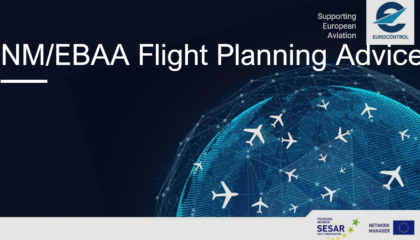
Europe’s airspace users expected to cover up to €5.4 bn in lost ANSP revenues through higher ATC charges beginning in 2023
12 May 2021, Brussels. Member States yesterday approved a revised regulation updating the EU-wide performance targets for air navigation service providers (ANSPs).
Previous targets set were based off of 2019 traffic levels, which have subsequently plunged by more than 60% last year[1] due to the COVID-19 crisis, government-imposed travel restrictions and the closure of EU borders. This has resulted in a €5.4 billion revenue shortfall for Europe’s ANSPs, who failed to react to the drop in traffic by reducing their expenditures accordingly. Across the wider aviation supply chain — and even beyond, the decision taken by Member States is unique. No other regulation, airport charges scheme or normal business contracting mechanism foresees airspace users shouldering previous losses from their suppliers, especially not in extraordinary times like the COVID-19 crisis, which is clearly a force majeure event.
During tense negotiations over the last six months, Member States have shown a complete unwillingness to follow the European Commission’s recommendations to take the long-term impact of the COVID-19 crisis on airspace users into account when setting updated performance targets for ATM services. Current forecasts indicate a recovery for EU airlines is not likely until 2024 at the earliest.
“Like airlines and other aviation stakeholders, air navigation service providers were expected to reduce their costs dramatically over the last year, reflecting the decline in traffic — and not simply continue with business as usual. While ANSP service requirements fell by 60%, they opted to reduce their costs by just 1%[2]”, said Thomas Reynaert, Managing Director, Airlines for Europe (A4E).
“The targets approved by States are by no means ambitious and will consequently impede the much-needed recovery of our sector, including airlines’ investment capacity to support digitalization and decarbonization solutions through our Destination 2050 initiative. States have rather chosen to protect their monopoly ANSPs and themselves from paying for revenue gaps from a crisis which has resulted in €22 bn[3] in losses for European carriers”, Reynaert added.
Alternatively, Member States could have made use of COVID-19 EU Recovery Funds, other national funding possibilities or existing regulatory mechanisms to close their ANSP revenue shortfalls, instead.
The updated targets clearly show the conflict of interest in the target setting process. Member States — as owners of the large majority of ANSPs — set the targets and can define how much profit they will make, whilst airspace users and their passengers remain at their mercy. The targets also reveal a lack of understanding by States about the long-term recovery needs of airspace users, including ambitious commitments to “build back better” from the crisis.
“At a time when airlines have already been financially crippled through no fault of their own, we are bitterly disappointed that States continue to throttle the economic and sustainable recovery of the aviation sector, essentially putting regional connectivity now even further at risk”, said Montserrat Barriga, Director General, European Regions Airline Association (ERA).
Airspace users urge ANSPs and Member States to support the industry’s recovery by reducing their costs and setting more challenging national performance targets, which would also benefit the environment by facilitating operational efficiencies. At the same time, Member States and the European Parliament must ensure that the ongoing revision of the Single European Sky framework (SES 2+) provides a meaningful and effective performance regulation for air navigation service providers that addresses the current imbalance and conflict of interests.
[1] Source: covid19-eurocontrol-comprehensive-air-traffic-assessment-15042021.pdf
[2] Source: Performance Review Body Monitoring Report on the Financial and Operational Impact of COVID-19 on the SES
[3] Source: https://www.iata.org/en/pressroom/pr/2020-11-24-01/
ENDS




